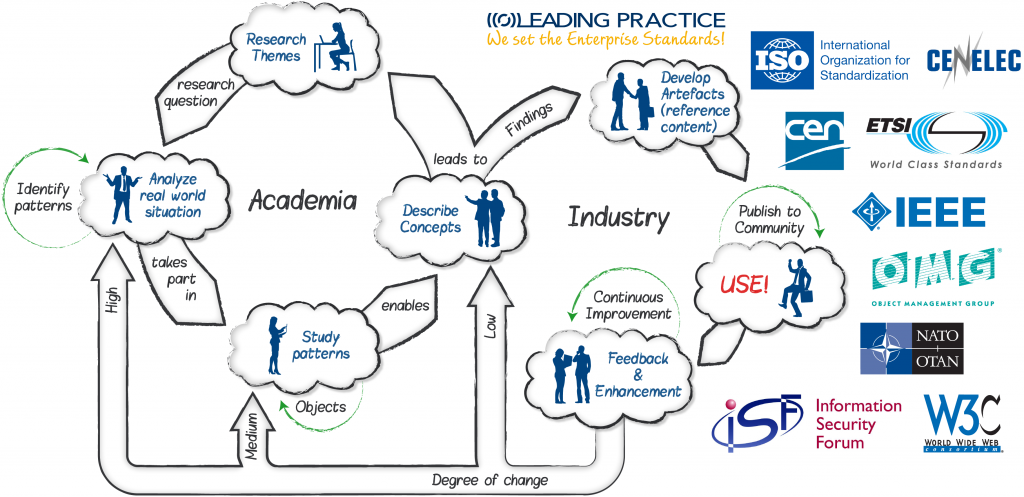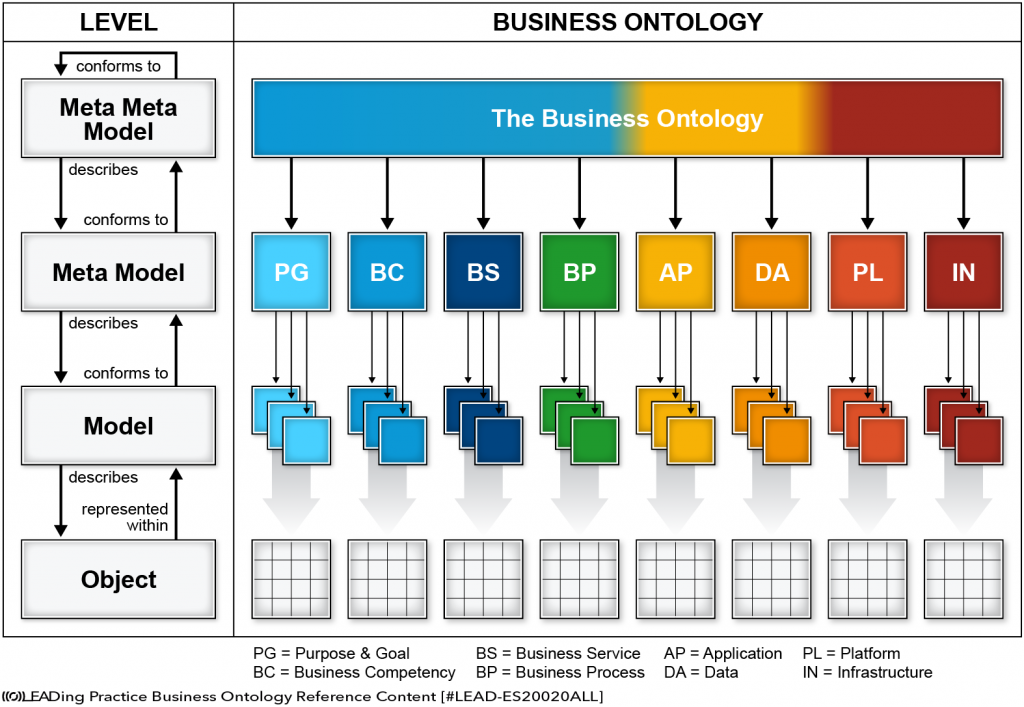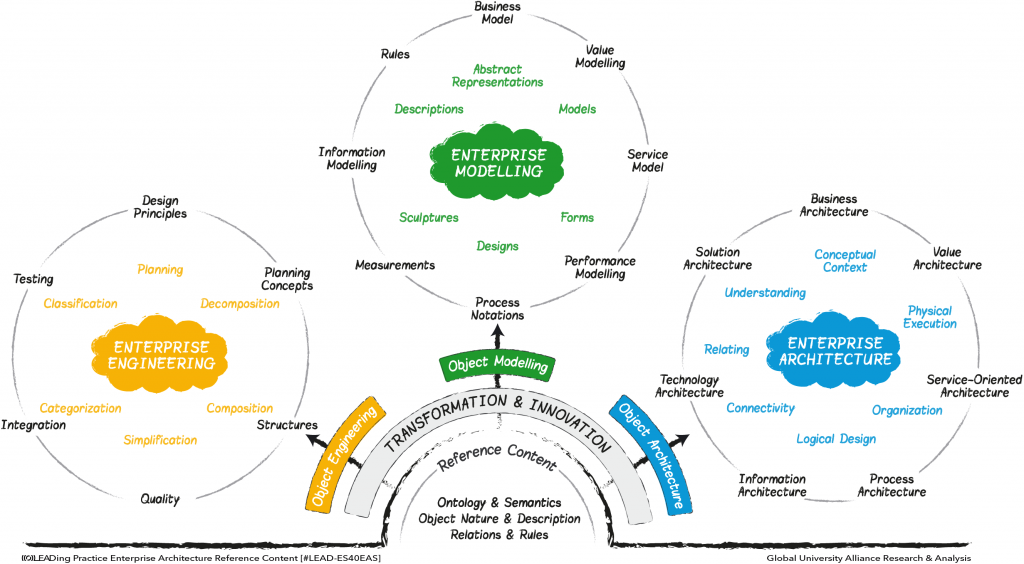Business Ontology
Business Ontology
Presented by Mark von Rosing DOI: 10.13140/RG.2.1.4141.4481[1]
The Business Ontology presented in this publication has taken the Global University Alliance members over a decade to research and develop, with hundreds of ‘man years’ involved to create the product introduced in this paper. This paper provides an overview of he business ontology research and analysis done and elaborates on its development and adaption journey. This research paper therefore has the aim to provide an overview of the research and analysis that has been done around the subject of Business Ontology. It does so by firstly defining what Ontology means in the context of this research after which it elaborates on the chosen research approach. It than describes how the Business ontology is a part of formalizing a Domain Ontology. Followed by a historic overview of the Business Ontology development adaption and how the business ontology is used to develop enterprise and industry standards. The Overview of the Business Ontology Research & Analysis paper than concludes with mentioning the main research team members.
What is Ontology in the context of the research
As ontology formally represents knowledge as a set of concepts within a domain, and the relationships between those concepts, it can be used to model a domain and support reasoning about concepts. The Global University Alliance has used the concept of ontology as both a shared vocabulary and the very definition of its objects and concepts. In order to go the next steps and fully use the potential of its ontology.
The Research Approach
The Global University Alliance (GUA) is an open group of academics with the ambition to provide both business and academia with state-of-the-art insights. Through its ties with the LEADing practice community, which includes large firms and governments, the GUA is able to evaluate and valorize its scientific output. Since 2004, the members of the GUA strive for a continuous improvement of their expertise through the research, comparison, analysis and development of Best and LEADing Practices in Business. Throughout this process, the GUA built its own implicit ontology that revolves around its expertise of Best and LEADing practices.
This is where the Global University Alliance (GUA) has developed a unique collaborative process between research and industry. After 5 years of already working together, the GUA was founded in 2004 as a non-profit organization and today (September 2015) they are an international consortium consistent of over 450+ professors, lecturers and researchers whose aim it is to provide a collaborative platform for academic research, analysis and development. As illustrated in figure 1, they do this through defining clear research themes, with detailed research questions, where they analyse and study patterns, describe concepts with their findings. This again can lead to additional research questions/themes as well as development of artefacts which can be used as reference content by practitioners and industry as a whole. What the GUA also does uniquely is the collaboration with standards bodies like:
- ISO: ‘The International Organization for Standardization (French: Organisation internationale de standardization)
- CEN: The European Committee for Standardization (CEN, French: Comité Européen de Normalisation).
- IEEE: Institute of Electrical and Electronics Engineers is the largest association of technical professionals with more than 400,000 members
- OMG: Object Management Group: Develops the software standards.
- NATO: North Atlantic Treaty Organizations (NATO’s) with the 28 member states across North America and Europe and the additional 37 countries participate in NATO’s Partnership for Peace and dialogue programmes, NATO represents the biggest non-standard body that standardises concepts across 65 countries.
- ISF: The Information Security Forum, Investigates and defined information security standards.
- W3C: World Wide Web Consortium-The W3C purpose is to lead the World Wide Web to its full potential by developing protocols and guidelines that ensure the long-term growth of the Web/Internet.
- LEAD: LEADing Practice, the largest enterprise standard body (in member numbers), which actually has been founded by the GUA. The LEADing Practice Enterprise Standards are the result of both the GUA research and years of international industry expert consensus and feedback on the artefacts and thereby repeatable patterns.

The Business Ontology: Formalising a Domain Ontology
All ontologies have a controlled vocabulary as a foundation. (Lassila & McGuinness, 2001) As the business ontology is an extensive ontology that has the ambition to cover all aspects of business (as opposed to academic ontologies), its terms are organized in a top-level domain and multiple intersecting subdomains (e.g., Business Competency, Business Process, Infrastructure). Figure 2 shows that the business ontology’s top-level has been formalised into the following four levels:
- Business Ontology Meta Meta Models
- Business Ontology Meta Models
- Business Ontology Models
- Business Ontology Objects

Historic overview of the GUA Business Ontology
The first GUA Business Ontology research was published within the LEADing Practice concepts in December 2004 and today resulted in the Business Ontology Framework. The Initial Business Ontology modelling and architecture principles yielded the attention of mayor software vendors like SAP AG, IBM, Software AG (IDS Scheer and ARIS). Some of these vendors used our entire conceptualization, while others adapted the Business Ontology meta-model or specific concepts e.g. eXtended BPMN concepts. IGrafx, which is a new player in the extended process modeling field, currently incorporates our modelling aspects into their methods and or meta-models.
Below is a short overview of the fast adoption of GUA-concepts by industry:
- 2009 our information ontology modelling and architecture concept was presented at SAPphire 2009 (SAP biggest customer event).
- 2010, our process and measurement ontology principles where presented at the IDS Scheer, ARIS Process World.
- 2010, the Official SAP book was published, using our Business Ontology principles: Taylor, J, von Rosing, M., von Scheel, H., Rosenberg, A., Applying Real-World BPM in an SAP Environment, Issue Date: 2011-01, Published by: SAP Press, ISBN: 978-1-59229-343-8, Page(s): 694.
- 2011, The Institute of Electrical and Electronics Engineers publishes a paper based on the research and findings around combining our Business Ontology process and architecture principles: Presten, T., Hove, M., von Rosing, M., Academic paper on Combining BPM and EA in Complex IT Projects, Published by: IEEE Commerce and Enterprise Computing Page(s): 271 – 278, Issue Date: 2011-05.
- 2010-2012, the Global University Alliance collaborated with TOGAF (The Open Group Architecture Framework) to develop the profession of a Business Architect, this included the business and process ontology modelling as well as architecture principles.
- 2010-2011, SAP adapted the process, value, measurement ontology modelling principles into their SAP ASAP Method, thereby the SAP customers apply the process, value, measurement ontology modelling principles within their blueprint, implementation, maintenance and upgrade methods and approaches.
- 2011-2012: Software AG-IDS Scheer enhace their ARIS process modelling meta model, based on the LEADing Practice ontology concepts.
- 2012: OMG & GUA start to collaborate on joints developments.
- 2012, the Government of Canada, uses the LEADing Practice Business Ontology modelling and architecture concepts to transform their organization as well as blueprint/implement SAP and Oracle ERP systems.
- 2012-2013: IGrafx, builds the entire LEADing Practice Business Ontology modelling and architecture concepts into their process flow, process modeller, performance reporting and enterprise modeler software.
- 2013, LEGO Group wins the Gartner Group‘s BPM award: Best BPM Transformation by leveraging the LEADing Practice Business Ontology principles.
- Sept 2013 LEAD 3.0 is published having the full Business Ontology concepts within them and has a community of over 2500 certified practitioners.
- 2012: Elsevier asks GUA to write officially with OMG/LEAD & GUA logo ‘The Complete Business Process Handbook’ series, which will consist of over 2100 pages together.
- 2013: German Government receives the GUA/LEADing Practice award of the year based on their extraordinary Service Oriented and BPM automation using extended BPMN and business architecture principles.
- 2013/4: OMG & GUA partnership moves to a strategic partnership.
- 2014: GUA members are asked to join the International Standardization Organization (ISO) to do joint developments (based on the Business Ontology).
- 2014: the US Government joint the LEADing Practice community and they do joint development around the Alignment Unity Framework and Reference Content.
- 2014: Prof. August-Wilhelm Scheer the fathers of process modelling, BPM as well as ARIS, receives a Life Time Award from the Global University Alliance and LEAD Community.
- 2014: NATO partners with GUA/LEAD to develop the enterprise standards for a 5-year timeframe.
- 2014/2015: John A. Zachman the fathers of Enterprise Architecture thinking today joins the Board of LEADing Practice and Global University Alliance.
- 2015: European Airtraffic Management Systems are coordinated across International countries using the GUA Business Ontology.
Developing Enterprise & Industry Standards based on the Business Ontology
The recent Business Ontology workgroup within the Global University Alliance, has adopted the concept of holistic Business Ontology Frameworks, as it identified the necessity of introducing such a framework into today’s enterprises through the LEADing Practice community. In order to develop this Business Ontology Framework, the GUA recently started looking for more mature business and enterprise ontologies that could provide them with state of the art semantics they could found their practices on. These practices should promote new ways of thinking, working and modelling about value identification, creation, and realization through the use of Business Ontology.
The Business Ontology concepts in the framework should provide sound semantic foundations for best and LEADing practices in different domains (e.g. process, service, value, information). The concepts and practices will be shared and published as an open standard in the LEADing Practice community. Thereby enabling all academics and practitioners in the community to build on common leading principles to identify, create and realize value, competitive advantage and agility to deal with future challenges. To realize this vision, the GUA alliance reaches out to all business and Business Ontology researchers to contribute to the consolidation of academic findings in a research-based Business Ontology Framework that can be used by industries and universities alike.
Based on the Business Ontology various Enterprise & Industry Standards have been developed. The standards are both agnostic and vendor neutral and are built on repeatable patterns that can be reused/replicated and thereby implemented by any organization, both large and small, regardless of its products/services or activities. All together describing the set of procedures an organization needs to follow in order to replicate the ability to identify, create and realize value in the specified area/subject. The Standards have been developed in the following ways:
- Research and analyze Industry Best Practice & Leading Practices.
- Identify common and repeatable patterns (the basis of our standards).
- Apply the identified repeatable patterns to the Business Ontology meta objects, models, meta model and meta meta model to develop a sound re-usable and replicable standard.
- By using the developed standard, capture the the common output to build specific accelerators within the standards, enabling to adopt and reproduce the Best & Leading Practices faster.
What the Enterprise & Industry Standards include
We realize that organizations apply various method and approaches, therefore we have ensured that based on the business ontology all our Industry Standards have a structured Way of Thinking, Working, Modelling, Implementation and Governance. To ensure full integration to other method and approaches within an organization, the industry standards have the business ontology and with it the semantic concept build in that allows for the industry standards meta objects to be reused and thereby applied.
This includes applying the standards to:
- engineering principles – how and where it can or needs to be decomposed and composed together,
- modelling principles – which design concepts can or should be applied, and;
- architecture principles – which architecture rules apply and which artifacts and templates e.g. maps, matrices and models could or should be used.

Creating the ability to use the Ontology and Semantics to develop standards with reference content, making it easier, less time consuming and cheaper to apply object descriptions, relations and rules to enable Enterprise Modelling, Enterprise Engineering and Enterprise Architecture. Developing whole new standards that are fully integrated and standardized based on a sound Business Ontology. While multiple standards have been developed linked or based on the business ontology[2], for an overview of the the standards developed in the LEADing Practice standard body, which is the GUA standardization arm please visit the referenced link[3].
Research Team
If you are interested in or would like to contribute to the Business Ontology Framework, do not hesitate to contact the coordinator.
Research Coordinator:
Professor Wim Laurier
Saint-Louis University Brussels & Ghent University, Belgium
LEADing Practice Coordinator:
Georg Etzel
LEADing Practice, Co-CEO
Global University Alliance Coordinator:
Professor Mark von Rosing
Head of Global University Alliance, Denmark
The members involved in this work have been a team that includes academics, researchers and analysts:
- Enterprise Ontology, Wim Laurier
- Enterprise Semantics, Simon Polovina
- Business Model, Mark von Rosing
- Business Process Management, Marlon Dumas
- Information Management, Hans Scheruhn
- Value & Performance Management, Maria Hove
- Enterprise Sustainability, David Coloma
- ERP, Karin Gräslund
- Enterprise Services, Maxim Arzumanyan
- Enterprise Modelling, Ulrik Foldager
- Measurement & Reporting, Ulrik Foldager
[1] OMG Standards: https://www.omg.org/news/releases/pr2014/10-29-14.htm.
[2] LEADing Practice Standards: https://www.leadingpractice.com/wp-content/uploads/2014/03/LEADing-Practice-Enterprise-Standards-Industry-Standards.pdf
Internet Standards: W3C www.w3.org/2001/11/StdLiaison#L
[3] Published in: https://www.researchgate.net/publication/287958619_Overview_of_the_Business_Ontology_Research_Analysis
